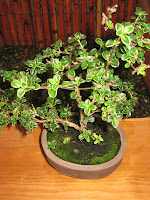We walked through the greenhouses, that are organized by category. Our first stop was the Succulent House. The plants aren't named "Succulents" because of they're tasty. These plants have adapted over time to survive with limited water available. As a result, they have hard waxy exteriors, and are able to store water. Examples of Succulent plants you might know include: Agave, Aloe, Cacti and Jade. Some of the Cactus plants we saw were over twenty years old!
 Our next stop was the Collections House. While the types of plants in this room vary, the common thread is that most are aromatic. Rubbing the leaves between our finger tips released the essential oils and each plant's unique scent. We smelled Lemon-grass, Basil, and Lavender, among other plants! We learned about the Mimosa plant, an herb that responds to touch. When you touch the tip of its of leaves, they fold inward. Its scientific name actually means shy! As soon as I figure out how to post the video, you'll be able to see it in action (in the meantime, I linked a video from youtube)!
Our next stop was the Collections House. While the types of plants in this room vary, the common thread is that most are aromatic. Rubbing the leaves between our finger tips released the essential oils and each plant's unique scent. We smelled Lemon-grass, Basil, and Lavender, among other plants! We learned about the Mimosa plant, an herb that responds to touch. When you touch the tip of its of leaves, they fold inward. Its scientific name actually means shy! As soon as I figure out how to post the video, you'll be able to see it in action (in the meantime, I linked a video from youtube)!
 The middle greenhouse is referred to as the Tropical or Rain forest House. Complete with bamboo benches, a pond with Koi fish, bullfrogs and a bridge, this space truly is a small rain forest in the middle of the UMass campus. There are Chewing Gum, Coco, Fig, and Banana trees along with Swiss Cheese plants, King Fern and Bamboo. Between the soothing music and warm moist air, it truly is a refuse for cold students in the middle of a New England winter.
The middle greenhouse is referred to as the Tropical or Rain forest House. Complete with bamboo benches, a pond with Koi fish, bullfrogs and a bridge, this space truly is a small rain forest in the middle of the UMass campus. There are Chewing Gum, Coco, Fig, and Banana trees along with Swiss Cheese plants, King Fern and Bamboo. Between the soothing music and warm moist air, it truly is a refuse for cold students in the middle of a New England winter. The second to last greenhouse is the Orchid and Exotic plant house. The common denominator for this location is that all of the plants grow in trees. Some of the plants, called Bromeliads, have thick and sturdy leaves that grow in such a way that they can pool water. This water is a source of sustenance for tree-dwelling animals, and can also be where tree frogs lay their eggs!
The second to last greenhouse is the Orchid and Exotic plant house. The common denominator for this location is that all of the plants grow in trees. Some of the plants, called Bromeliads, have thick and sturdy leaves that grow in such a way that they can pool water. This water is a source of sustenance for tree-dwelling animals, and can also be where tree frogs lay their eggs!
 Our final stop was the Bonsai and Chamilia greenhouse. Some of the Conservatory's oldest plants can be found in this space. I'll be discussing the facility's history in the next paragraph, but it's important to note that the building was damaged a couple of time since its creation in the mid 1800s. A handful of the original plants are located in the last room we visited, meaning they're over 100 years old! The Bonsai plants truly are works of art. For the past two years, a Bonsai master from Japan has come to the conservatory to assist with shaping the trees.
Our final stop was the Bonsai and Chamilia greenhouse. Some of the Conservatory's oldest plants can be found in this space. I'll be discussing the facility's history in the next paragraph, but it's important to note that the building was damaged a couple of time since its creation in the mid 1800s. A handful of the original plants are located in the last room we visited, meaning they're over 100 years old! The Bonsai plants truly are works of art. For the past two years, a Bonsai master from Japan has come to the conservatory to assist with shaping the trees.The Durfee Conservatory was built in 1867. In 1883, the buildings were seriously damaged by a fire. The facility was renovated ten years later, to be damaged again after an oak tree fell during a hurricane. An entirely new facility was constructed in 1954 and is what is currently available. A new greenhouse is slated for construction on campus, in addition to the Conservatory in the next year or so.


No comments:
Post a Comment